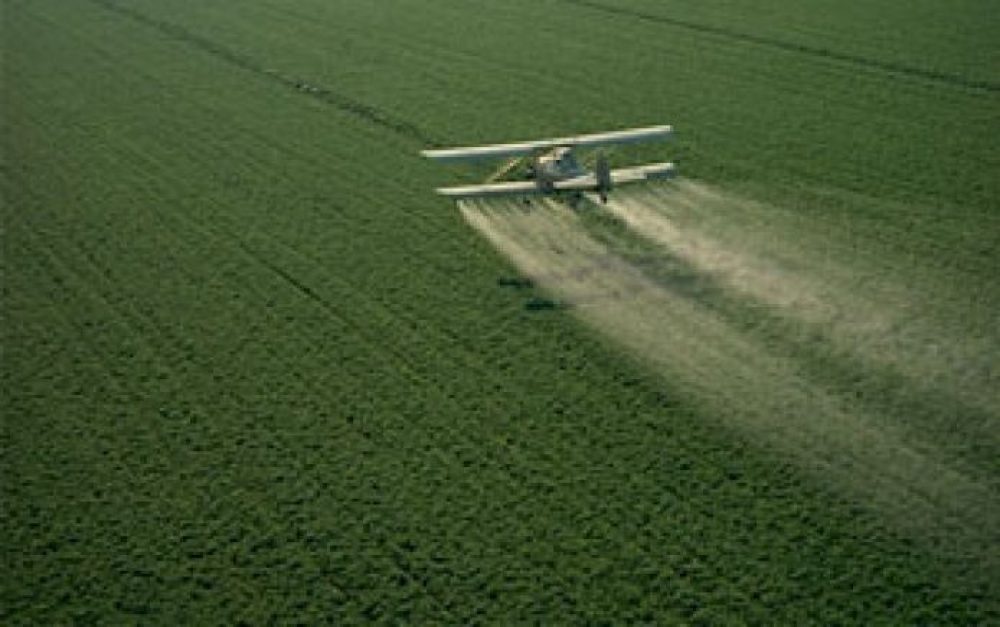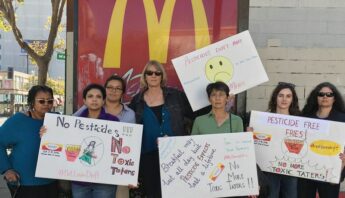Last month, the U.S. Department of Agriculture (USDA) released compelling findings from a study on the air-borne movement (aka "drift") of the pesticide endosulfan in Florida.
Researchers found that this soon-to-be-banned persistent pesticide traveled miles from tomato fields where it was applied, and that drift levels jumped significantly during spray season. More details on the study are outlined below, but first consider this: with USDA stepping into the ring to document pesticide drift, is it possible that EPA and USDA might actually look at pesticide use and regulations together? Now that would be interesting news indeed.
Pesticide drift has been a big PAN focus for some time. Our drift-related policy work — generally aimed at EPA — focuses on pushing for greater public health protections, especially for children. USDA has been the agency that (as a general rule) actively supports continued use of conventional pesticides in farming, though some key programs do focus on more sustainable practices.
So it's interesting and exciting to see USDA shifting gears to focus on the reality of pesticides drifting off-site.
Endosulfan drifts far & wide
It was USDA’s Agricultural Research Service (ARS) that conducted the study and released the report “The Pathways of a Shape-Shifting Pesticide” late last month. They looked at the long-distance movement of the highly hazardous pesticide endosulfan.
USDA researchers studied the movement of endosulfan from where it was applied near the eastern coast of Florida towards two inland sites — Everglades National Park and Biscayne — both more than ten miles away. The study, conducted between 2001 and 2006, found a predominance of the most volatile form of the pesticide (alpha-endosulfan) at all three sampling sites. Pesticide levels in the air were significantly higher between October and May, the peak of the growing season.
Endosulfan will be phased out of Florida tomato fields by December, 2014.
The researchers confirmed that endosulfan in the air resulted from both spray drift of the applied pesticide and volatilization (change to a gaseous phase which facilitates dispersal in the air).
Another interesting finding was that the less volatile form of the chemical actually transformed into the more volatile form. This kind of transformation can and often does happen after pesticides are applied, and this must be considered when evaluating both movement through the environment and toxicity to workers, neighbors or other organisms.
Endosulfan is an old, bad insecticide in the organochlorine family. It's on track to be phased out of use in Florida tomato fields by December, 2014. Because it's persistent and bioaccumulates, it's also slated for an international ban under a global treaty.
A new kind of collaboration?
It's EPA that's responsible for the evaluation of human health and environmental hazards associated with agricultural pesticides, and for putting the necessary policies in place to protect the public from those hazards. That’s why so much of our attention is focused on working with pesticide-affected communities to pressure EPA to be much more rigorous in protecting children, agricultural workers, farm-area residents and consumers from exposure.
At the same time, we fully recognize that the most effective way to prevent pesticide-related illnesses and environmental contamination is to avoid their use altogether. That's why we actively promote the widespread adoption of organic and other practices that rely on ecological crop and pest management that use least toxic pesticides only as a last resort.
The best way to prevent pesticide-related harms is to avoid their use altogether.
So, once the current crippling government shut-down passes, we’ll get back to the business of working with partners around the country to push for a full, fair farm bill — one that fully supports innovative farmers who understand and implement those practices that protect our soil, water, air, pollinators and other wildlife, as well as the rural economies of which they are an essential part.
Wouldn’t it also be great if the government agency that's supposed to help farmers grow and market food that's healthy for consumers, workers and the environment could collaborate with the government agency charged with protecting human health and the environment from the hazards of pesticides?
Lord knows things don’t change very fast in Washington, D.C. We’ll be lucky if the government can quickly open its doors again. But I wouldn't be working in a place like PAN if I didn't believe change can happen. So I will plow ahead and continue to work on these issues, surrounded by an incredible community of like-minded, action-oriented partners and colleagues. ¡Si se puede!
Photo credit: USDA








